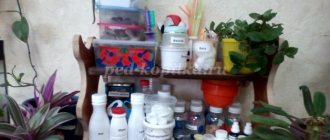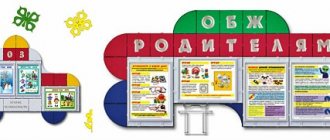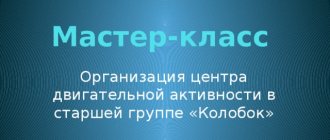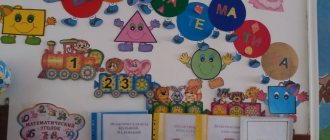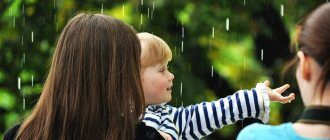Drawn pictures
Any product drawings are excellent material for:
- speech games;
- conversations;
- speech therapy exercises.
It is useful to use together both sets of subject cards with images of food and plot pictures of this topic.
Healthy and unhealthy food products are shown separately in pictures for children; it is important to teach children to easily distinguish between them.
Cards with drawn pictures are suitable for:
- classes;
- games;
- exercises.
Principles for forming the names of children's development centers
There are a large number of different options for names for children's development centers, both associative and not related to the institution's activity profile. A detailed analysis of the names of existing centers allows us to determine the basic principles of their formation, outlined below. After familiarizing yourself with them, as well as with numerous examples, you can create an original and successful name for your own business.
- Names associated with intelligence and the activities of a children's development center. Popular options are those that use keywords related to mind, intelligence and knowledge (“Nauchilus”, “KRUGOZOR”, “Poznavaika”, “I am a Genius”). The names of famous scientists sound interesting and original (“Socratic”, “Pythagoras”, “Da Vinci”, “Little Einsteins)”. In addition, associative names can reflect the specifics of the center’s work, the programs and approaches used (“Menard”, “The Magical World of Montessori”, “Linguisticum”).
- Titles related to cartoons and fairy tales. Since the activities of children's development centers are aimed at the child, most of their names are related specifically to children's topics. These are the bright and memorable names associated with cartoons, fairy tales and their characters (“Cheerful Cheburashka”, “Cheshire Cat”, “Gingerbread House”, “BARMALEYKIN”).
- Names related to childhood and children. This group includes, first of all, options that include different combinations with the word “childhood” (“Island of Childhood”, “Childhood Time”, “Miracle of Childhood”, “CHILDHOOD ACADEMY”) and the words “kids”, “baby”, “ child” (“Bravo Kids”, “Kids Up”, “BABY BOOM”, “It’s a child”). In addition, many variants of names that do not contain keywords evoke direct associations in visitors with childhood and children (“Toddlers”, “Daughters - Sons”, “Mama’s Joy”, “Egoza”).
- Other original titles. Many entrepreneurs prefer to choose a name that does not evoke obvious associations with the activities of the development center, but is easy to remember and evokes positive emotions (“Smile”, “Bright Start”, “Rainbow”).
Creation and work of a speech development corner in kindergarten: role, significance, goals and objectives
The child’s speech develops gradually. By the age of 1.5 years, the first simple sentences appear: “Give me a drink,” “Give me,” etc. By the age of three, the vocabulary is approximately 1,500 words, the child composes complex sentences, uses conjunctions, and comes up with new words. Thus, already in the younger groups of kindergarten, increased attention is paid to speech classes with children.
The process of speech acquisition is a complex process that occurs in all types of children's activities. The Federal State Educational Standard (FSES) identifies a separate area - “Speech development” - and puts forward requirements for the work of a teacher in this area. In addition to developing and conducting standard and integrated speech classes, the teacher of a preschool educational institution is tasked with organizing the subject-spatial environment in the group. In order to develop and, if necessary, correct the speech skills of pupils of all ages, several corners are set up - book, speech therapy, theatrical and speech.
The speech corner involves conducting classes individually and in subgroups of 2-3 students. It also becomes one of the centers of children’s independent activity; they are pleased and interested in studying visual materials and playing here. The purpose of creating a corner for speech development is the optimal organization of a developmental environment for improving the speech abilities of pupils.
The tasks of the speech corner directly depend on the age and individual characteristics of the children.
Table: tasks of the speech corner
Experimentation corner in the nursery group
Kristina Avetisyan
Experimentation corner in the nursery group
The period of 1.5–3 years is a time of active development in the physical and mental areas. The child changes, orients himself better in space and explores the environment. In his actions, a cognitive interest appears, which he transfers into play activities. An adult needs to use these moments of spontaneous interest to develop basic research skills and show kids that they can get positive emotions from experimental work with simple objects.
The purpose of research activities in a children's laboratory is to promote the development of children's cognitive activity, curiosity, desire for independent knowledge and reflection.
One of the conditions for solving problems in experimental activities in kindergarten is the organization of a developmental environment. The object environment surrounds and influences the child from the first minutes of his life. The main requirements for the environment as a developmental tool are to ensure the development of active independent children's activities.
in the experimentation corner there is placed a collection of minerals, a set of research materials available for children’s experimentation (stones, various types of clay, sand, etc., magnifying glasses, containers for conducting experiments, reference literature. The experimentation corner in this case is equipped for the period necessary for consolidation of ideas about the properties of minerals and is limited to 1-2 weeks.It is a whatnot on wheels with shelves on which materials and equipment are placed.
In addition to the movable experimentation corners, the group is also equipped with a stationary zone for experimental activities , in which children work independently. The materials in this zone are distributed in the following areas: “Sand and water”
,
“Sound”
,
“Magnets”
,
“Paper”
,
“Light”
.
The main equipment in the corner are :
•assisting devices: magnifying glasses, compass, magnets;
• various vessels from various materials (plastic.)
•natural material: pebbles, clay, sand, shells, cones, feathers, moss, leaves, etc.;
•recycled material: pieces of leather, fur, fabric, plastic, cork, etc.;
•different types of paper: plain, cardboard, sandpaper, copy paper, etc.;
•dyes: food and non-food (gouache, watercolors, etc.)
;
•medical materials: pipettes, flasks, wooden sticks, syringes (without needles, measuring spoons, rubber bulbs, etc.;
•other materials: mirrors, balloons.
When setting up an experimentation corner, the following requirements must be taken into account:
• safety for the life and health of children;
• sufficiency;
• location accessibility.
Design of the speech development center
The speech development center is equipped and staffed in accordance with the age of the pupils. Thus, every year it is transformed and enriched to make it interesting and productive for children to study here.
For younger preschoolers, the speech development corner may include a sensory area - a place for the development of fine motor skills. As an option, this is a table with SЂР°Р·РІРІРІР°СЋС‰РёРјРё играми: pyramids, a sorter, books and toys with buttons, bags with seeds and pebbles.
This could be a rug on the wall with buzzers, rubber bands, a plastic mirror, buttons, felt pictures, ribbons, and Velcro. The sensory mat usually depicts the plot of a fairy tale familiar to children (“Turnip”, “Teremok”, “The Three Little Pigs”) or images of natural objects, animals: flowers, trees, butterflies, birds, bunnies, etc. Everyone knows that a child’s first he actually wants to touch the object that interests him, so a developmental rug is made from pieces of bright fabric, scraps of velvet, printed ribbon, and colorful braid.
For all age groups of preschoolers, objects and play sets for the development of speech breathing should be presented in the corner. For these purposes, waste material and simple toys are used: plastic tubes and cups, ping-pong balls, cotton balls, plumes and pinwheels, flags, воздушные шарики. The teacher includes breathing exercises in play activities.
In the speech corner of the senior and preparatory groups, a place is set up for board and printed games. The selection is made up of games with letters and words:
- “Entertaining ABC”: for cards with letters (uppercase and printed), you need to select cards with images of objects for these letters. “ABC Lotto”: cards with beeches are filled with chips with animals whose names begin with these letters. “Kaleidoscope of Letters”: children learn to recognize the symbolic designations of letters on the playing field. “Make a word. Dominoes: cards are used to create an image and its name. “Who lives where”: cards with words, animals and their habitats.
To stimulate children's verbal creativity and play dramatization games, a small area with a screen, decorations, and dolls is set up in the corner. Unlike the theatrical activity corner, the space for performances in the speech corner is limited. For example, you can cover a cardboard box - it will be a fairy-tale forest for the figurines. Dialogue using hand puppets and bibabo can be acted out from behind a folding paper screen.
Requirements for the speech development corner according to the Federal State Educational Standard for Preschool Education
Optimal location: the corner is sufficiently lit, located in a quiet place next to the book, theater and sensory development corners. Compliance with the age and individual needs of children. The presence of an animated character - a doll or toy. The character who owns the corner encourages children to engage in speech activity: he tells funny stories, invites them to play, and asks questions. With the help of an animated toy, a demonstration of motor exercises and gymnastics is carried out. Aesthetics. The corner is designed in the same style as the areas for artistic reading and theatrical activities. The place of study attracts not only with bright colors, but also with interesting objects: reproductions on the wall, figurines on the shelf. Didactic and gaming materials are located in a corner by topic, and students learn to maintain order. Safety. Pupils of the first and second junior groups independently practice the development of fine motor skills under the supervision of a teacher (due to the danger of small parts getting into the respiratory tract). It is not recommended to equip the speech corner with hanging shelves or cabinets with glass doors. Electrical appliances and power supplies must be out of the reach of children.
Names of the speech development center
The name of the developmental activity corner in kindergarten should be short and understandable. Traditionally, the activity center is named after the actual focus of the activity. Since a mandatory attribute of a speech corner is an animated toy, the name of this fantasy character is often used in the name. Unusual and funny names arouse additional interest among students. You can arrange a competition for children and parents to come up with a name.
- Classic names: “Speech Corner”, “Speech Coach”, “Speech Development Corner”, “Learning to Talk”, “Speech Development Lessons”.
Titles with the name of the owner of the corner: “Lessons of Aunt Owl”, “Hello, Dunno!”, “Visiting Luntik”, “Button Invites”, “Talker”, “Mushka the Talker”, “Bunny the Lopotushka”.
Funny names: “Let's Talk”, “Gazebo”, “Zvukarik”, “Govoryashka/Govorusha”, “Azbukvarik”, “ABVGDEyka”, “Govorilki”, “Logostrana”, “Let’s Sit and Talk”, “Rechetsvetik”.
Contents of the speech development center
A special place in the speech corner is given to the animated character. The kids talk with this toy or picture in a playful way, he “sends” them parcels with new games and letters with tasks.
For the children's activity center, environmentally friendly (plastic, wooden, upholstered) furniture is selected. Cabinets, chairs and tables should be comfortable and suitable for the height of children. Sample list of furniture for a speech corner:
- Wardrobe/rack with shelves. Table or shelf for temporary exhibitions. Desk and chairs.
Equipment in the speech development corner:
Mirror. To perform articulation exercises, the child needs to monitor his facial expressions, learn to independently control and direct his actions. The mirror should be securely mounted on the wall and located at the work desk, firstly, it is convenient for the child during class, and secondly, this eliminates the risk that children will accidentally touch the mirror and it will fall.
Audio recorder, TV. One of the components of speech development in kindergarten is enriching the auditory experience of pupils. Children hear literate speech, correct pronunciation, and logically constructed statements—their culture of oral communication is formed. For this purpose, audio tales and recordings of artists reading poems are listened to in the speech corner. Watching short videos serves as material for building further conversation.
Magnetic board. As mentioned above, such a board can be used to post current information, display photographs and illustrations on the topic of the lesson. But more often it is used for students to perform exercises. For example, in the following tasks: “Arrange the pictures in the correct sequence to form the plot of a fairy tale. Try to retell it,” “Make words from the letters of the magnetic alphabet...”, “Distribute the pictures by topic, come up with a name for each of them.”
Experimental activities at an early age
Dear friends, we are pleased to once again introduce you to Lyubov Vladimirovna Sukhanova, teacher at MBDOU “DSKV No. 46” in Bratsk, Irkutsk region. Today Lyubov Vladimirovna will kindly share her professional experience in organizing experimental activities at an early age. The article will be of interest to teachers of early age groups.
A short commentary on the article from Lyubov Vladimirovna:
“Kids love to experiment. This is explained by the fact that they are characterized by visual and effective thinking, and experimentation, like no other method, corresponds to these age-related characteristics. In preschool age it is the leader, and in the first three years it is practically the only way to understand the world.”
Useful reading...
Experimental activities at an early age
The desire to observe and experiment, to independently seek new information about the world around us are the most important features of normal child behavior. Research activity is a natural, biologically inherent state of a child. Every child is a researcher from birth. He is determined to understand the world. It is this internal desire for research that gives rise to exploratory behavior and creates the conditions for the child’s mental development to initially unfold in the process of self-development.
Many teachers and psychologists talk about the advantages of the experimentation method. But in reality, it is rarely used in the activities of young children. Despite many positive aspects, it has not yet become widespread.
Kids love to experiment. This is explained by the fact that they are characterized by visual and effective thinking, and experimentation, like no other method, corresponds to these age-related characteristics. In preschool age it is the leader, and in the first three years it is practically the only way to understand the world.
In the activity of experimentation, the child acts as a kind of researcher, independently influencing in various ways the objects and phenomena around him in order to more fully understand and master them. As knowledge about the object under study accumulates, the child gets the opportunity to set new, increasingly complex goals.
When deprived of the opportunity to get acquainted with the world around him through experimentation, the child’s mental development is inhibited.
In the process of experimentation, the youngest preschooler gets the opportunity to satisfy his inherent curiosity, to feel like a pioneer, a researcher.
The process of cognition is a creative process, and my task is to support and develop a child’s interest in research and discovery, and to create the necessary conditions for this.
Experience shows that elementary experimentation is already accessible to young children. They enjoy exploring objects. When choosing a method for introducing young children to the world around them, I chose experimental activities. Children should not only observe the objects they study, but also expose them to influences, modify them, and highlight new properties and qualities in them. A child should receive knowledge about a particular subject not as a bare fact, but as a result acquired in the process of searching and thinking.
To increase interest in experimental activities, I organized a laboratory where “Scientific Gnomes” conduct research. Children put on caps, turn into inquisitive characters and carry out joint experimental activities - making new scientific discoveries. Children believe in miracles and, at the level of fairy-tale reality, gain new rich knowledge and useful life experience.
The goal of the project is to create conditions for the development of children’s cognitive activity in the process of experimentation.
As a result of project activities, I try to solve the following problems:
1. Introduce children to methods of studying different objects (gradually connect all types of perception; help examine objects, highlighting their properties and qualities; encourage them to include hand movements in the process of getting to know the object, trace parts of the object with their hands, stroke them; perform actions of an experimental nature).
2. To form ideas about the properties and qualities of objects (teach to determine weight parameters, temperature qualities, material of manufacture; introduce the ability of magnets and obtaining intermediate shades when mixing paints, recognize objects by the sound they make, introduce sources of light and heat)
3. Develop analytical abilities (the ability to compare, correlate, group, establish the identity and difference of homogeneous objects according to a common property, establish physical laws).
4. Include children in practical cognitive activities of an experimental nature (observations, conversations, experiments) together with adults. Perform actions in accordance with the task, use modeling actions.
5. Stimulate cognitive activity, observation, curiosity.
6. Develop attention and memory, auditory differentiation, tactile sensations, fine motor skills.
7. Develop communication skills and proactive speech in the process of interaction.
I work with 3-year-old children in the amount of 7 people in the afternoon in joint activities.
The subject-spatial environment in the group is equipped with the material and equipment necessary to develop children’s cognitive interest in experimental activities:
Various vessels: plastic, glass, metal;
Technical materials: nuts, paper clips, bolts, nails.
Natural materials: pebbles, sawdust, feathers, sand.
Recycled material: wire, fabric, plastic, corks, caps.
Equipment: flashlights, electric lamp, rulers, syringes, tubes, sticks, containers, boxes.
Tools: magnets, magnifying glasses, mirrors, safety scissors.
Materials: paper, foil, fabric, sandpaper.
Items: small rubber and plastic balls, magnets, candles, wax pencils, wooden and metal spoons, buttons.
This project is aimed at bringing the child into contact with objects and materials. Elementary experiments with them make it possible to understand their properties, qualities, and capabilities; stimulate curiosity, a desire to learn more, and enrich them with vivid images of the world around them.
The experimental work is planned in stages, with subsequent complication. Initially, kids get acquainted with paper and fabric, learn to recognize things from these materials, and become familiar with the properties and quality characteristics. I suggest the children wash two dresses - one made of paper, the other made of fabric. Through practical actions, I bring the guys to the conclusion that paper is not intended for making clothes, it gets wet and breaks down in water, but the fabric retains its integrity. When conducting other experiments, children get acquainted with other characteristics of these materials: they learn that things are cut, wrinkled, absorbed, wet, stretched, torn.
In further research activities, children get acquainted with materials such as wood, metal, rubber, plastic, glass. They learn to recognize objects made from these materials and distinguish them by visual and tactile characteristics. During practical activities, children identify the surface structure of objects, their density, elasticity, thickness, flexibility, and thermal conductivity.
Children learn that the weight of objects depends on the material they are made of.
Thus, during the experimental activity “Masha and the Bear,” children group objects by weight (light – heavy) depending on the size of the fairy-tale character. Masha and the bear choose toys that each of them wants to take with them to their friends. There are several options for choosing toys:
• toys made of the same material, but different in size. I ask why Bear will take larger toys, and I check the children's answers by weighing the toys in their hands;
• toys are made of the same material, but some are hollow inside, while others are filled with sand. I ask what toys Masha will take and why;
• toys of the same size made of different materials. I find out who will carry what toy and why.
Then I invite the children to choose a “treat” in buckets that Masha and the Bear can carry, and I find out: how to find out which bucket Masha can carry and which the Bear can carry? We check the children’s assumptions by examining the contents of the buckets with them.
The “What Sounds” and “Sounds of Objects” experiments lead children to understand the causes of sound - the deliberate impact of a person on objects contributes to the occurrence of certain noise effects. Children learn to recognize objects by the sound they make and associate them with the sounds of nature and musical instruments.
The series of studies “Magic Rays” forms in children an idea of light sources: natural and man-made. I introduce children to ways of using objects: a candle, a flashlight, a lamp. In the course of practical activities, I come to the understanding that illumination depends on the power of the source.
Experimental activities such as Hocus Pocus and Magic Power introduce children to the power of magnets. Practical actions help to identify objects that interact with a magnet and lead to the conclusion that a magnet attracts only metal objects.
Thus, in the course of experimental activities, a young child learns to observe, think, compare, answer questions, establish cause-and-effect relationships, and follow safety rules.
The effectiveness of experimental activities is not possible without interaction with the family.
Consultations on “Experimental activities in kindergarten” and “Organization of children’s experimentation at home” contributed to increasing the information experience of parents. And the use of modern technologies (showing the presentation “Children’s Experimentation”, booklet “Young Researchers”) contributed to the emergence of interest in research activities at home.
Parents are actively interacting and information is currently being exchanged via email to create a World of Discovery photo album. I offered parents files of game-experiments for experimenting at home, and as feedback I receive photographs of the experimental activities carried out at home. There is a desire for further interaction.
Summing up my work, I came to the conclusion that by encouraging children’s curiosity, quenching the thirst for knowledge of little “whys” and by directing their active motor activity, we contribute to the development of cognitive activity, enriching children’s ideas about the environment in the process of experimental activities.
Literature:
- Approximate general education program for preschool education “From birth to school”, edited by N.E. Veraxes; M, Mosaic - Synthesis, 2014
- “Organization of experimental activities for children 2-7 years old, Thematic planning, recommendations, lesson notes” Authors - compilers E. A. Martynova, I. M. Suchkova Volgograd: Teacher, 2011.
- Tugusheva G. P. Chistyakova A. E. “Experimental activities of preschool children” SP: CHILDHOOD - PRESS, 2007
